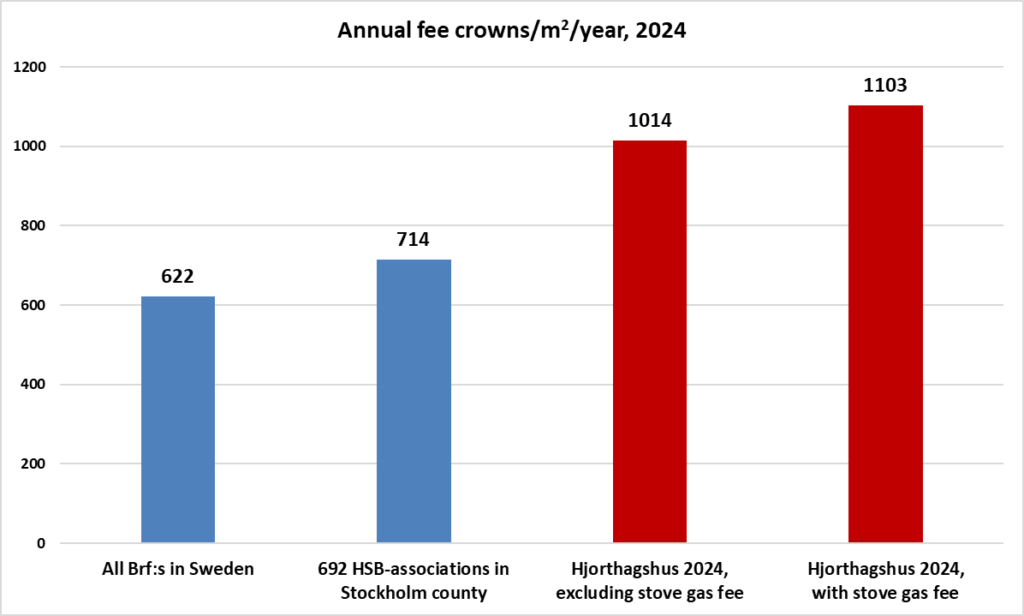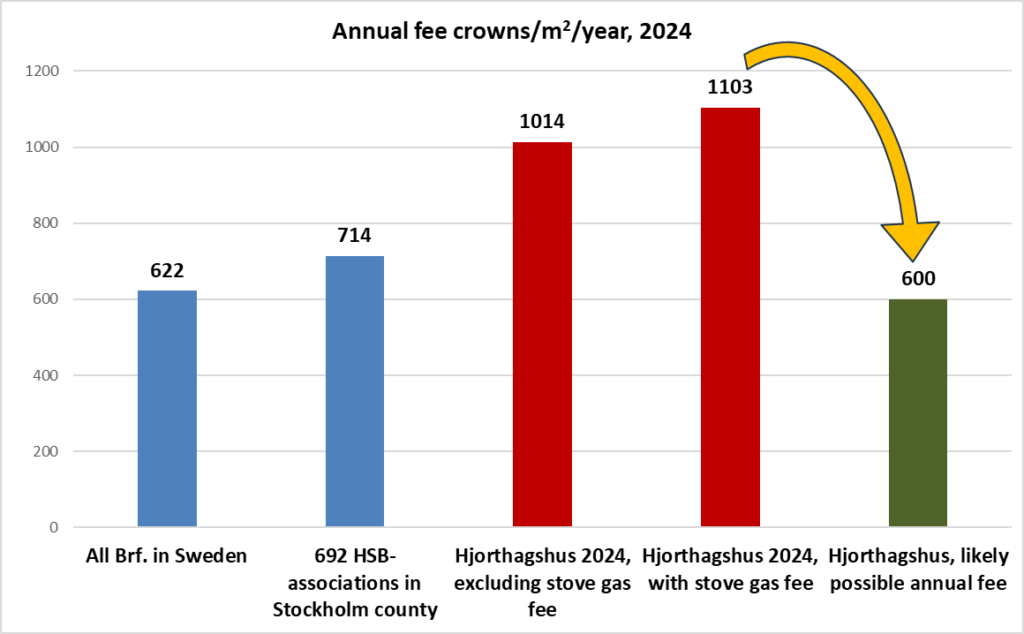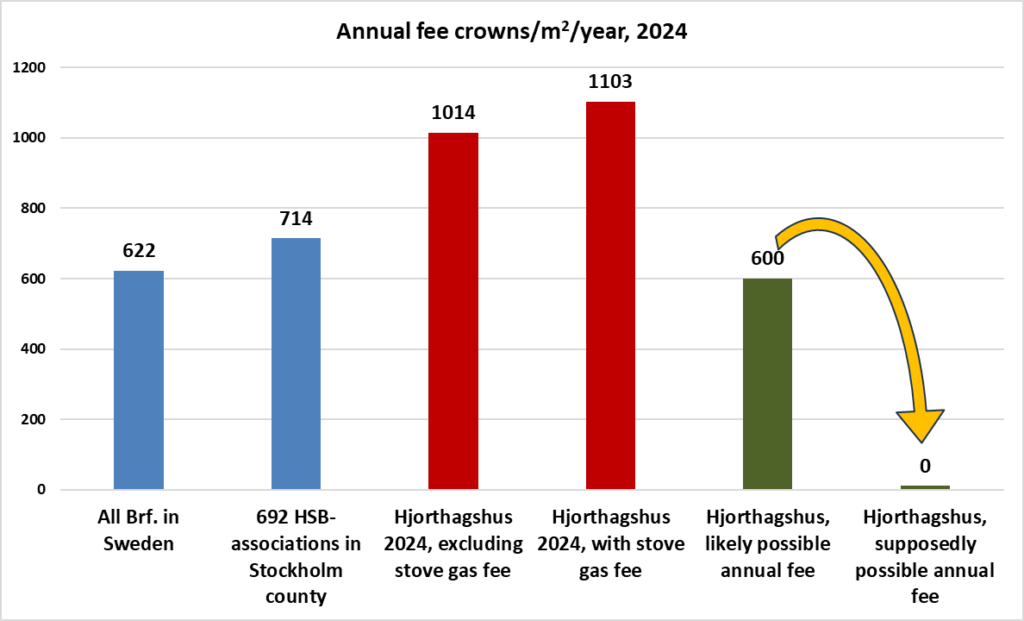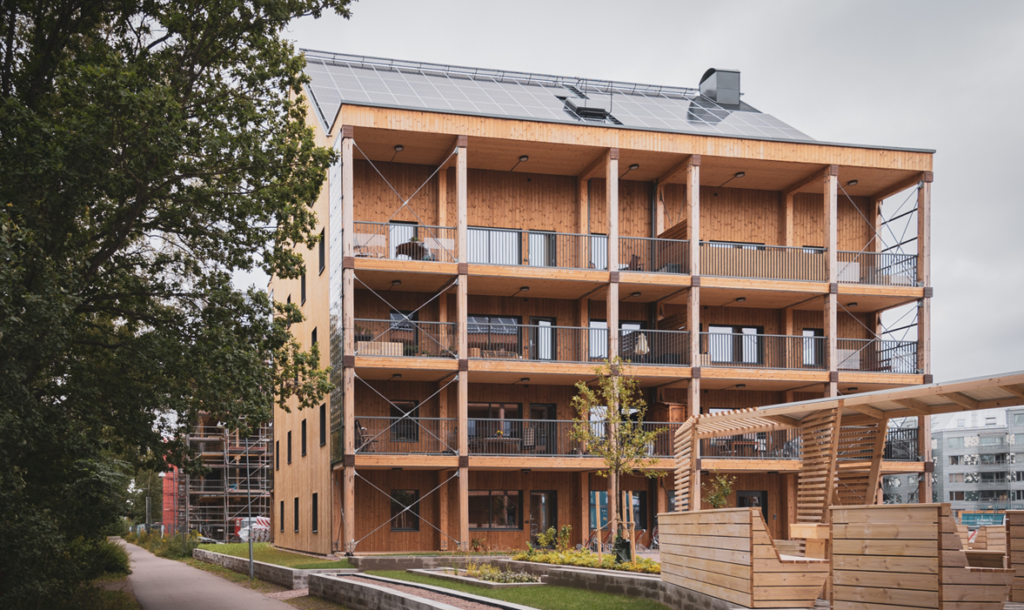This page uses financial figures from Brf. Hjorthagshus. The association has possibly among the highest annual fees in Sweden for comparable tenant-owner associations. The reason for the high annual fee is mainly the sky-high energy costs, but neglected financial, maintenance and technical management also contributes. Below is a relevant comparison with other associations.

Regarding the energy losses, two independent reviews, submitted to the board in 2018 and 2022, have shown measures needed to be taken to reduce these losses. Unfortunately, the energy investigations have not led to action.
.
Increased annual fee 1 January 2025
The 10 percent increase in the annual fee as of 1 January 2025 decided by the Board was not necessary. The increase gives the association a new income of approximately SEK 1.5 million, but during the first half of 2025, the association’s energy losses can be reduced by the same amount. When energy losses are eliminated, it is done with permanent measures that lock energy use at a lower level. Managing the increased energy costs by increasing the annual fee means that the annual fee will have to be increased the next time energy prices rise. The increase leads to financial instability, while the reduction in the association’s energy use leads to financial stability.
After the increase, the association’s monthly bill for 40 m2 amounts to SEK 3,718. If all profitable measures for energy efficiency and improved management are implemented, the monthly bill will drop to around SEK 2,000. The calculations are presented below. Members who own an apartment of 40 m2 get an annual reduction in housing costs of SEK 20,600 (and an increased apartment value). Perhaps the expression “Less is more” fits well here?
.
The associations accumulated energy costs
Below are the estimated energy costs for members’ housing in 2024.
| Energy purchases, total in 2024 | SEK/year |
| District heating | 3 800 000 |
| Building electricity | 450 000 |
| Household electricity | 760 000 |
| Stove gas | 1 190 000 |
| Total externa costs which disappears after Deep Energy Retrofit (DER) | 6 200 000 |
The above costs disappear completely with comprehensive energy efficiency. Hjorthagshus buildings have an advantageous location directly on bedrock and large unobscured roofs, which together allow energy autonomy when carefully implemented. The costs of household electricity and stove gas are interesting because they can be internalized (“brought home”) to the association and become an income that makes it possible to lower the annual fees.
.
The association’s costs and the annual fee after Deep Energy Retrofit and improved management
When energy purchases have ceased after energy retrofit are reduced at the same time as various maintenance costs come down. All in all, a considerable reduction in the association’s costs becomes the end-result. On the maintenance side, it’s mainly the recurring window renovation that disappears when maintenance-free low-energy windows are installed. Costs for roof material replacement also cease. Finally, there will be several opportunities to improve management in order to reduce costs.
Some new income arises from improved management, for example through increased rental of empty premises and the sale of electricity to members and charging poles. New costs will be depreciation and interest payments for investments in the energy retrofit programme. The investments raise the assets on the balance sheet and thus increase the value of the association’s buildings. The loans will appear on the liabilities side of the balance sheet and are partly eaten up by annual inflation..

.
The large, permanent final financial improvement allows for a reduction in the annual fee to approximately SEK 600/m2/year.

Deep Energy Retrofit is not a “quick fix” that happens overnight. The whole process will probably take 4 – 6 years. On the other hand, the result can be predicted with fairly high probability through the project plan showing which planned technical installations and because more measures can, if necessary, be supplemented. To understand that the outcome is possible, visits can be made to buildings that have already undergone the process.
.
Inflation, annual fees and profits from energy efficiency measures
Inflation has a very significant impact on future energy costs. Every year, energy costs increase with inflation added to previous years’ inflation (similar to the interest-on-interest effect). The accumulated costs will in the long run have a major impact on the annual fees that the association must charge its members. The graphs below show the cost developments at different inflation rates. Though, investments in energy efficiency are made in nominal amounts and decouple the association from the future price spiral with inflation-on-inflation on energy prices.

The inflation rate of 2 per cent (blue line) is the future inflation rate that we know will come because the Swedish central bank – the Riksbank – promises it. By steering the economy towards a low inflation rate, the risk of deflation, which could be particularly damaging to the economy, is reduced. As for energy prices, they have risen well above the general inflation rate of 2 percent over the past decade. Over the past 10 years, electricity prices have risen by an average of 7 percent per year. District heating has increased by an average of 11 per cent over the past two years. The Energy Markets Inspectorate has given the go-ahead for sharp future increases in electricity prices to promote the expansion of Sweden’s electricity grid. District heating companies have faced increased competition for biofuels and warn of new future price increases. In addition, they must invest in carbon capture equipment, which will have an upward pressure on the price of district heating. An uncertainty factor for price development is that more and more property owners are shutting off the district heating, which means that the district heating company has to spread its fixed costs over fewer customers, which is also likely to increase the price of district heating.
Hjorthagshus does not need to buy any energy at all. Through energy efficiency and investments in its own energy equipment, the association can become self-sufficient in energy. Investments of approximately SEK 58 million will give an annual cost for depreciation and interest of SEK 2.2 million during the depreciation period. This fixed cost is shown in the chart above with the horizontal green line. The interest rate must be fixed so that the future cost of the investments is fully known. The total amount of SEK 58 million corresponds to SEK 3,700 per m2 of apartment space, or just under 5 percent of the apartment value of the association’s tenant-owned flats. The investment is thus small in relation to the value of the flats. At the same time, the value will increase by about 15 percent (see below). The association is responsible for the investment, but the 15 percent value increase goes to the members.
The chart above shows that already at the known future inflation rate of 2 percent, a guaranteed profit of about SEK 316 million occurs. If the average energy price inflation instead becomes a fully possible 6 percent, a profit of about SEK 615 million will be brought to the association. This corresponds to an annual average profit of approximately SEK 17 million/year. When the association through investments “takes home” the profits of the energy companies for itself and the members, economists call the tactic of internalization – the association assimilates the income and profits of others. The big winners will be the members, who will receive significantly lower annual fees.
.
Who actually pays for the investments and interest?
The association pays for the investments to the bank with monthly transfers for amortization and interest. Whose money is actually being used to pay the bank? Economists think that it is actually the energy companies that pay the costs of reducing energy use and use the term internalization for the tactic. The association uses the money that would otherwise have been sent to the energy companies for to pay the bank; the energy companies’ revenues and profits are “brought home” to the association.
Of interest is that several changes to the buildings are “permanent”, i.e. they remain even after the depreciation period ends. Examples are low-energy windows, additional insulation, ventilation pipes and boreholes for geothermal heating. Once the cost of depreciation has ceased, many measures continue to serve their purpose of reducing the association’s energy costs and climate impact. Although then the profitability is considerably higher after the depreciation period.
.
Wealth increase for members
Energy autonomy for the association will lead to increased values of members’ tenant-owned apartments. The higher valuation occurs thanks to several mechanisms:
- Low annual fees
- Immunity to future energy price increases
- Increased living comfort
- Minimal climate impact “feels good”
For the value to increase, current deficiencies in the maintenance of the buildings must be fixed and the garden must restored to good condition.
A reasonable assessment is that the apartment value will rise by at least 15 percent when all measures are implemented. In associations which have carried out Deep Energy Retrofit, there is an increase in value at this level when compared to equivalent tenant-owned apartments in the same area. Given that the association shares with new apartment speculators the plan for energy autonomy, minimal climate impact and low annual fees, some increase in value will take place already when the association initiates the measures (the expectation effect). An increase in value of 15 percent means that today’s value of around SEK 75,000/m2 will rise to SEK 94,000/m2.
A 40 m2 apartment increases in value by SEK 450,000… without that the member actually having done anything…


Of interest is also the total increase in wealth for the members, which is likely to amount to at least SEK 175 million.
.
Let the annual fee become zero?
There are tenant-owner associations with zero annual fees. Good financial management with real and financial savings has resulted in the positive situation. A few associations have real and financial savings with large surpluses and must pay dividends to the members, who are thus paid for living in their homes. Unusual but it occurs.
In addition to low housing costs, there are other advantages for associations with large real and financial savings. The association can take out loans for maintenance measures at no cost because the interest rate and amortizations on the loans are lower than the return on the savings which the association has.

.
Hjorthagshus can use the profits from energy efficiency improvements for financial savings with returns. Commercial banks offer discretionary management, which means that the bank manages the association’s assets and uses historical statistics on returns for various investment opportunities. For example, the association can order a 10 percent return on its financial savings.

If Hjorthagshus uses the profits from energy efficiency programme for financial savings, part of the return from the savings can be used to reduce annual fees, which will then move towards zero. In the long term, the association can potentially pay dividends to its members.
It is important to remember that returns are not guaranteed. It can be less or very low, but also higher than the planned return. In the event of a low returns, the association can discontinue its financial savings and switch to savings in real assets. Some tenant-owner associations with large financial savings have switched part of their savings to real assets to balance the risk of low returns from financial savings. Our pension funds have long worked with a balance between real and financial assets. The balance of risk has deemed it necessary because financial assets are considered to have a long-term higher risk.
.
Legal aspects
A tenant-owner association is legally an economic association (with the same purpose as a limited liability company). Therefore, in the Brf. Hjorthagshus’ Statutes, § 1, there is the following paragraph: “The purpose of the association is to promote the economic interests of its members…”. The wording is taken word for word from the Swedish Act on Economic Associations, § 4: ” …/… has the purpose of promoting the economic interests of its members …/….”.
In the drafting of the Act, it is stated that membership in a tenant-owner association must be (financially) advantageous. (The writing in the draft is essentially part of the law.) Unfortunately, it is financially disadvantageous to be a member of Hjorthagshus. The association’s long-standing policy of repeatedly raising annual fees when energy prices and other cost items rise instead of investing in upgrading the buildings and reducing operating costs has yielded an unfortunate result: comparatively high annual fees, depressed value of members’ tenant-owned apartments and high climate impact. It is possible that the board’s policy is in conflict with the Statutes and the Act on Economic Associations. Regardless of any rule violations, the policy is generally unfavourable for the members, provides poor housing comfort in housing and should therefore end.
